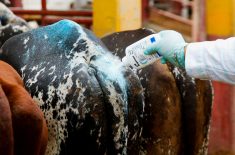Chicago Mercantile Exchange live cattle and hog futures on Wednesday gained as funds sold, or rolled, the February contract and bought deferred months, traders said.
CME livestock fund investors liquidated their February long positions, and mainly bought April futures, in a procedure known as the “roll” by followers of the Goldman Sachs Commodity Index (S+PGSCI).
Wednesday was the first of five days for the S+PGSCI roll process.
Sharply higher wholesale beef prices kept February futures from sliding into negative territory after the shift by funds.
Read Also

U.S. grains: Soy futures post biggest monthly gain in nearly five years on China trade optimism
U.S. soybean futures climbed to a 15-month high and posted their biggest monthly gain in nearly five years on Friday following a rally fueled by the prospect of revived exports to China.
The Wednesday morning wholesale price, or cutout, for choice beef surged $2.49 per hundredweight (cwt) from Tuesday to $209.80. Select climbed by $2.98 to an all-time high of $206.54, according to the U.S. Department of Agriculture.
Analysts attributed wholesale beef price gains in part to recent changes in the way USDA calculates specific beef cuts within the cutout.
Back-to-back holiday plant shutdowns and recent weather disruptions to livestock production put less fresh beef in the hands of end users.
And processors raised the cost of beef at wholesale to offset record-high prices for cattle.
Last Friday, the cattle in the U.S. Plains moved at mostly $137 to $138/cwt, eclipsing the prior week’s $133 to $136 record, feedlot sources said.
“You have to have good wholesale prices to justify paying up to $138 for cattle,” said Dan Vaught, economist with Doane Advisory Services.
This week, cash cattle bids of $135/cwt surfaced in Kansas against $140 asking prices from sellers, feedlot sources said.
Wednesday’s live cattle futures’ upswing and strong beef cutout performance could lend cash cattle price support this week, traders and analysts said.
Packers may further curtail operations to limit cash spending and shore up their sagging margins.
Beef packer margins were estimated at a negative $80.25 per head, compared with a negative $76.45 per head on Tuesday, as calculated by HedgersEdge.com.
February live cattle ended unchanged at 136.525 cents. April and June finished 0.625 cent higher at 136.975 and 129.95 cents, respectively.
CME feeder cattle drew support from higher live cattle futures and lower corn prices.
January feeder cattle closed at 168.475 cents/lb., up 0.425 cent. March finished at 168.55 cents/lb., 0.725 cent higher.
Hogs turn up as specs buy
CME hogs posted modest gains, helped by speculative buying after Tuesday’s losses in anticipation of lower cash prices, traders and analysts said.
February hogs closed up 0.05 cent/lb. to 85.575 cents, and April ended at 91.1 cents, 0.375 cent higher.
“People were probably doing some bargain hunting after factoring in Tuesday’s market selloff,” Vaught said.
USDA’s morning direct hog market prices were not available. Hogs in the Midwest traded steady to $1 per cwt lower, according to hog dealers.
They said some packers in the Midwest are unable to coax hogs from farms that remain isolated by dangerous county road conditions caused by recent winter storms.
Other processors are buying hogs for the rest of the week to make up for weather-related downtime, traders said.
— Theopolis Waters reports on livestock futures markets for Reuters from Chicago.











